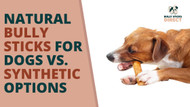Stickin' to the Facts: Natural Bully Sticks for Dogs vs. Synthetic Options
Aug 02, 2024
Dogs love to chew. And one of the most healthy ways for them to entertain themselves is by getting their teeth into something that smells and tastes great with an appealing texture and lasts a while so that they can focus on exercising this natural instinct.
Originating from the necessity to use all parts of the animal in meat processing, bully sticks have developed from a butcher's by-product to a mainstream dog chew. Bully sticks are one of the most popular dog treats because they are sturdy and are considered a safer, more digestible alternative to rawhide.
These natural products have traditionally dominated the market. However, with new manufacturing processes available there are a number of synthetic products now on the market that mimic the behavior of bully sticks and other treats.
As pet owners we should be fully aware of the suitability and quality of products on the market before making a decision on which treat to buy out beloved pets, since vendors in some countries don't have the standards that we have in the good 'ol US of A, where any consumable pet product has to adhere to strict safety standards, ensuring they are safe and effective. Moreover, these are often FDA-regulated.
So lets cover off the pros and cons of natural vs synthetic bully sticks so you can make an informed decision about what to treat your best furry friend.
What are Synthetic and Natural Bully Sticks Made From?
Natural Bully Sticks are single ingredient products, made entirely from dried bull pizzle that has been prepared through a meticulous process of stretching, cleaning and drying the raw material. The simplicity of the ingredient list often attracts pet owners seeking natural pet food options. The slow-roasting process helps retain the bully sticks' own juices, enhancing the flavor and providing additional health benefits for dogs
Synthetic Bully Sticks are made from pairing rubbers, plastics, and compounded edible dental materials, and may incorporate colorants and flavoring to mimic the chewing experience of natural sticks.These sticks are made to provide the same fulfillment as traditional bully sticks for dogs. Synthetic sticks, nonetheless, involve intricate manufacturing processes that combine materials into a uniform texture and shape.
Durability and Longevity
The lifespan of natural bully sticks can vary depending on the dog’s chewing habits, but they normally last long enough to provide extended chewing without quick disintegration. Generally, the natural bully stick is crafted for long vigorous chews of up to 90 minutes.
Synthetic bully sticks are created for durability. Their lifespan can exceed that of natural bully sticks, making them a cheaper solution for vigorous chewers. This is specifically advantageous for households with multiple dogs. The synthetic material is engineered to not break down quickly and as such uses non natural binders that are consumed as dog chews through the material.
Digestibility
Being natural meat products, natural bully sticks are extremely digestible for your furry friend. They break down with ease in the canine digestive system. Synthetic dental chews, while safer than rawhides, are not the best when it comes to digestion. The material itself should be confirmed to be approved for your pooches consumption. Plus, if large pieces are swallowed, they can cause gastrointestinal issues and discomfort leaving your dog uncomfortable and anxious.
Chewing Satisfaction
Natural bully sticks are made from animal product which has been part of the canine food chain for thousands of years. The natural instinct of a dog is to "sink their teeth" into a material that rips and tears apart with force, but not too much force to cause damage. The keen sense of smell and taste for a dog is instinctively tuned to enjoy its own food source, which a natural bully stick is a legitimate source of.
Additionally natural bully sticks come in all sizes and thicknesses to cater to the lightest chewers to even the most aggressive chewers.
Synthetic bully sticks are made from materials that need to bond together to provide resistance to chewing rather than absorb the bite. The teeth tend to bounce or scrape off the surface. Artificial scent can be pleasing to a dog, however it doesn't compare to an original food source.
These differences drastically affect the ability of synthetic alternatives to fully replicate a natural chew.
Flavor and Palatability
Many dogs prefer natural bully sticks due to their bold meaty flavor, which is more attractive than the often chemically enhanced flavors of synthetic sticks. However, manufacturers of synthetic sticks often incorporate a range of flavors to increase appeal, from peanut butter to bacon.
Taste tests typically show a preference for natural bully sticks, though some dogs do enjoy the many flavors of synthetic options.
Allergen Considerations
Natural sticks can pose allergen risks, in particular to dogs sensitive to beef proteins. While generally hypoallergenic, the chemical additives and synthetic materials in these sticks can also trigger allergies in dogs with sensitivities. Both types require attention regarding allergens, but synthetic sticks might offer a small advantage for extremely sensitive dogs due to fewer organic allergens.
Chemical Additives and Preservatives
Natural sticks are commonly free from additives, aligning with trends toward cleaner pet diets and owevers can avoid exposing their animals to fillers and toxins. Synthetic sticks may contain different additives to enhance flavor, durability, and color, necessitating scrutiny by pet owners. While many additional ingredients used in synthetic sticks are considered safe and approved, the long-term effects of chronic exposure to these chemicals are not very clear. Read the ingredients thoroughly to ensure that the chews are right for your dog.
Storage and Shelf Life
Natural sticks should be kept in a cool, dry place to maintain quality and prevent spoilage. Synthetic sticks benefit from being less affected by heat and direct sunlight and therefore degradation of materials. Both products should be stored in an air-tight container to keep them longer lasting. Natural sticks have a shorter shelf life due to being organic, whereas synthetic sticks can last indefinitely under proper storage conditions. Pay attention to how long you have had the bully sticks and if they are still in top condition to give to your dog.
Impact on Dental Health
Natural Bully Sticks are part of an animal that dogs have been consuming as part of their evolution. They can help clean a dogs' teeth by reducing tartar build-up and plaque, promoting better dental health. Synthetic Bully Sticks also aid in dental care by reducing tartar and plaque build up. However, do take care to make sure that the material is not too hard to break and damage your dog's teeth, especially in aggressive chewers. Also, check the ingredients to ensure that the product has been officially approved for use with your pet.
No matter the choice, a good diet and regular dental check-ups remain crucial to maintaining a dog’s dental health.
Synthetic vs Natural Bully Sticks, Which Offers Better Value?
The answer depends on your priority. If costs and longevity are important then synthetic chews may be the best option as they last long and are generally lower cost.
However, while synthetic sticks may have a longer shelf life, natural bully sticks offer a more superior experience for your dog, through, scent, taste and texture, moreover the extra health benefits like protein intake present better overall value for the health-conscious pet owner.
How Do I choose what is right for my dog, or puppy?
Choosing between synthetic and natural bully sticks largely depends on your dog's health requirements and preferences. Natural sticks are highly flavorful, digestible, and offer dental health benefits, while synthetic versions are more cost-effective and durable, suitable for dogs with allergies and heavy chewers. Responsible pet owners should weigh these options against their dog's dietary sensitivities and chewing habits. Supervising chew sessions is important to avoid choking or digestive issues. By understanding the impacts and characteristics of each type, owners can make informed choices that promote their dogs' health, satisfaction, and safety.
If you'd like some assistance making this choice don't hesitate to reach out to us and we'll be happy to help and if you're interested in our range of fully FDA approved bully sticks, check out our Guide to Selecting the Right Bully Stick for your Dog!



